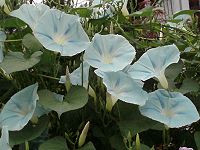Morning glory


Morning glory is a common name for over 9,000 species of flowering plants in the family Convolvulaceae, whose current taxonomy and systematics is in flux. Morning glory species belong to many genera, some of which being:
- Calystegia
- Convolvulus
- Ipomoea
- Merremia
- Rivea'
- Astripomoea
- Operculina
- Stictocardia
- Argyreia
- Lepistemon
Contents |
Habit
The flower usually lasts for a single morning and dies in the afternoon. On a cloudy day, the flower may last until night. New flowers bloom each day. The flowers usually start to fade a couple of hours before the petals start showing visible curling. They prefer full sun throughout the day and mesic soils. Some morning glories, such as Ipomoea muricata, are night blooming flowers.
In some places such as Australian bushland, morning glories develop thick roots and tend to grow in dense thickets. They can quickly spread by way of long creeping stems. By crowding out, blanketing and smothering other plants, morning glory has turned into a serious invasive weed problem.
Cultivation
In cultivation, most are treated as perennial plants in frost-free areas and as annual plants in colder climates, but some species tolerate winter cold. There are some species which are strictly annual (eg. I. nil), producing many seeds, and some perennial species (eg. I. indica) which are propagated by cuttings. Some moonflowers, which flower at night, are also in the morning glory family.
Because of their fast growth, twining habit, attractive flowers, and tolerance for poor, dry soils, some morning glories are excellent vines for creating summer shade on building walls when trellised, thus keeping the building cooler and reducing heating and cooling costs.
Popular varieties in contemporary western cultivation include 'Sunspots', 'Heavenly Blue', the moonflower, the cypress vine, and the cardinal climber. The cypress vine is a hybrid, with the cardinal climber as one parent.
Gallery
References
External links
- w:Morning glory. Some of the material on this page may be from Wikipedia, under the Creative Commons license.
- Morning glory QR Code (Size 50, 100, 200, 500)











